Bob Mayer's Blog, page 32
November 22, 2020
Day 257: 2020 Pandemic. Preparation and Survival Task #8. Continue Your Area Study: Your Home, Prevent Choking, Suffocation.
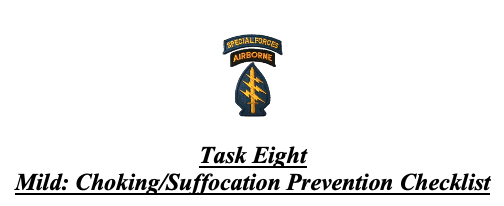
Hand in there. We’ll get to the exciting stuff soon enough.
To prevent choking and suffocation
There’s a reason certain toys are designated for certain ages. What a child can put in their mouth, they will put in their mouth.
When putting babies to sleep make sure there is nothing around them that can cause suffocation.
Watch children during meals. Do they know how to chew properly before swallowing? Cut up food for younger children into bite-sized portions. Stay away from hard candy and foods that can obstruct the airway.
Put trash bags and other plastic bags in places where children can’t get to them. The same with the plastic bag that comes back from the dry-cleaners.
Secure batteries, particularly button batteries, from children.
Task Eight
Mild: Choking/Suffocation Prevention Checklist
Keep small toys, items out of reach of toddlers
Clear sleeping areas for babies from all possible items that could smother them
Keep trash bags and plastic bags out of reach of children
Keep batteries, especially button batteries, out of reach of children
November 21, 2020
Day 256: 2020 Pandemic. Preparation and Survival Task #7. Continue Your Area Study: Your Home, Prevent Poisoning.
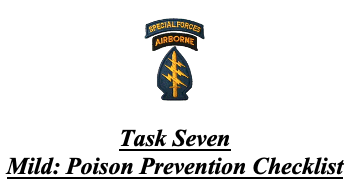
I know these tasks about the home seem mundane and not as sexy as learning to start a fire with a box and piece of wood, but I emphasize the things you’re more likely to deal with first. The most likely threats.
It is more likely for children to be seriously hurt or killed by ingesting a toxic agent.
To prevent poisoning
Label all unmarked liquid containers. If you wonder what’s in that old plastic jug or bottle, assume it’s poison. NEVER use food or drink containers to store hazardous material.
Store cleaning products safely and out of reach of children.
Store medicines securely and out of reach of children.
Put child proof cabinet locks on all doors within reach of children.
Have the poison control phone number posted in your kitchen and on speed dial on your cell phone. 800-222-1222.
Never mix household cleaning products together. Some don’t like each other and produce toxic gasses, particularly bleach and ammonia.
Never mix medicines together without consulting a doctor or pharmacist. Or call the poison help hotline which is monitored 24 hours a day and they can give you advice: 800-222-1222.
Monitor your heaters and fireplaces for CO2 emissions. Have fireplaces cleaned yearly.
Task Seven
Mild: Poison Prevention Checklist
Post Poison Control # Prominently in kitchen: 800-222-1222
Label all unmarked liquid containers
Insure all cleaning products are stores out of reach of children
Insure all medications are stores out of reach of children and have childproof caps
Never mix medications without approval
Monitor all heaters and fireplaces for CO2
Have fireplaces and chimneys cleaned annually
November 20, 2020
Day 255: 2020 Pandemic. Preparation and Survival Task #6. Continue Your Area Study: Your Home, Part I
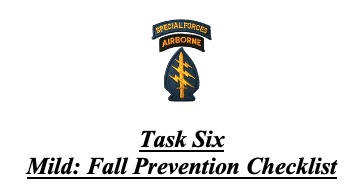
When we think survival, we picture someone out in the wilderness in a pine tree lean-to, but we spend most of our time in our home and it’s easy to overlook what we can do to make that environment safer. It is far more likely, in fact a given, that you will experience one of the accidents or emergencies listed in this section.
When I research, I find statistics that are all over the place because people can’t agree on definitions. Once more, those statistics are variables that differ from home to home, so I won’t quote many (those of you with pocket protectors and calculators can google them) but let’s do an Area Study for your home in terms of the most likely areas of concern.
Falls are a leading cause of injury and death. This is more likely based on the previous part of the Area Study: your personal physical condition. Older people, naturally, are more susceptible to falls and getting injured. One in three people, 65 or older, will suffer a fall leading to serious injury, if not death.Poisoning goes in the opposite direction for susceptibility: it is more likely for children to be seriously hurt or killed by ingesting a toxic agent.Children are also susceptible to choking, suffocation, drowning and scalding. This includes airway obstruction.Water leads to drowning. Do you have a pool? Water nearby?Fires and burns are likely dangers.
To prevent falls
Clear clutter. Pick things up and put them away. How many times have we tripped over something that doesn’t belong on the floor?
Look at your rugs. Are the edges secured? Are folds flattened? Do they slide? Use tape and rug mats underneath to prevent this.
Bathroom: place grab bars and non-slip maps in all bathrooms. The bathroom is very dangerous because water and soap makes things slippery; and if you do fall you’re going to hit something hard like a counter or tile floor. We never land on the fluffy pile of freshly laundered towels, do we?
Lighting: make sure all areas are sufficiently lit, particularly staircases. When we lived in a 100 year old house, a back stairwell didn’t have a light in it. The stairs also turned near the bottom. We bought a number of motion sensor, battery powered lights and put them in that stairwell and all over the house. Often we placed them just as you enter a room, inside the door jam or on the wall, low down. They have been life-savers.
Always wear slippers or shoes with rubber soles. I can attest to the danger of just socks on wooden stairs. Never a good combination.
Make your stairs safe. If you have small children or they visit, become an expert at installing childproof gates at the top and bottom of stairs. Have handrails for all stairs.
Use ladders properly and do not exceed specifications. Always place on solid footing. Have someone hold taller ladders at bottom when in use. Make sure leaning ladders are placed against a solid point.
Task Six
Mild: Fall Prevention Checklist
Clear Clutter
Secure edges of all rugs
Secure rugs to floors so they don’t bunch or slide
Place grab bars and non-slip mats in bathrooms
Make sure all stairways and dark areas are adequately lit
AMIR motion sensor light: https://amzn.to/2LwlkKY
Wear Slippers or shoes with rubber bottoms at all times
Childproof stairs with gates at top and bottom
Do all stairs have handrails?
Use ladders properly according to specifications
November 19, 2020
Day 254: 2020 Pandemic. Preparation and Survival Task #5. Continue Your Area Study
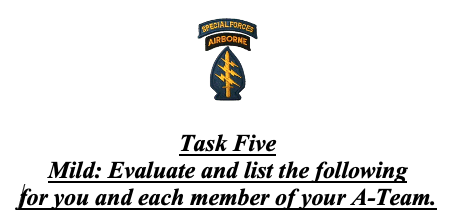
Further evaluate the people on your A-Team.
Task Five
Mild: Evaluate and list the following for you and each member of your A-Team.
Name:
Overall Physical Condition:
Medical Status:
Allergies:
Medications:
Ability to walk/run:
Swimming ability:
Able to drive? What types vehicles?
Special Needs:
By looking at these checklists you can see what assets and liabilities you and your A-Team have.
November 18, 2020
Day 253: 2020 Pandemic. Preparation and Survival Task #4. Start Your Area Study
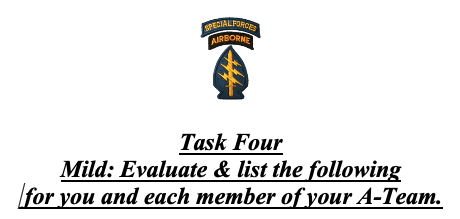
One size does not fit all. A key step in preparation I found most preparation and survival books skip is the Area Study. This allows you to tailor the preparation that’s going to follow this task. There will be several tasks to complete under Area Study.
In Special Forces, prior to deploying to an Area of Operations, we conducted an Area Study. An Area Study is examining your area of operations with the perspective of evaluating assets and threats so you can properly prepare. An Area Study will tighten down your preparation and focus on things in order of priority for your specific situation. It’s not just the environment, but also includes yourself and your team. Then you study home, your work, school, and any other locales where you, and people on your A-Team, spend a significant amount of time. When taking a trip, you should conduct a travel area study, examining the route you will take, your destination, and your route back.
There are so many cases where a thoughtful Area Study followed up by the appropriate preparations would have saved lives. Preparation is so much better than reacting. Which is what we’re doing now.
Area Studies can have non-emergency uses, such as if you’re considering moving to a new place. An Area Study can provide valuable decision making data.
What special skills and background do you have? The people on your team?
These include medical, construction, problem solving, military, the list is basically about coping with a mild emergency that isn’t life-threatening. The key is to know what you can and can’t do, and what those around you can and can’t do. Think back to the last emergency experienced—what was the reaction? The answer to this will give a heads up to how one will react in the next emergency. There is no right or wrong answer, but awareness helps.
These skills include medical, military, gardening, hunting, survival training and experience, pilot, boat operation, camping, weapons, cooking, land navigation, swimming, communication (personal and technical) construction, problem solving, fire starting, knot tying, the list goes on and on. Think back to the last crisis encountered. What was the instinctual reaction? Some people can react well others panic. This is a reality that has to be factored into any scenario.
[image error]
Task Four
Mild: Evaluate & list the following for you and each member of your A-Team.
Name:
Ability to react in an emergency:
Special Skills Background #1:
Special Skills Background #2:
Special Skills Background #3:
Special Skills Background #4:
Overall physical condition
This includes ability to walk, how much of a pack one could carry, physical disabilities, allergies, medical status, special needs, etc.
November 17, 2020
Day 252: 2020 Pandemic. Preparation and Survival Task #3: A First Aid Kit

For future tasks, I include specific information about gear and equipment. The items linked are for reference purpose. I personally have all things listed. Feel free to search further for what you want. I need to disclose I am using affiliate links for items on Amazon and the GAIA app later on. Not just because it’s required, but to understand I am giving examples and linking to things on Amazon makes it easier to show gear as there’s an overwhelming amount of things out there. One rule of thumb: the cheaper the gear costs, the cheaper the gear.
Also, any money made off affiliate links is donated to charity, primarily the Special Operations Warrior Foundation.
Also, sometimes things are no longer available, so I add the item description. Please email me if any links to gear, web sites, etcetera are no longer valid and I can update immediately.
You can get whatever you want, wherever you want. Also, if you want to talk to experts, I recommend finding the closest REI store or local outdoor store and talking to the people who work there.
Many households don’t have a basic first aid kit. If you don’t, it’s critical that you have one. I’ll have more information on medical gear later, but at least a basic kit to start.

Task Three
Mild: If you don’t have one, get a first aid kit for your home.
Example:
M2 Basics First Aid Kit
November 16, 2020
Day 251: 2020 Pandemic. Preparation and Survival Task #2: Contact Information, Emergency Numbers and Alert Flow; IRP and ERP.
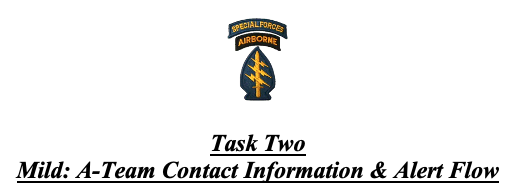
Unless you plan on being totally alone in an emergency there are others who are on your “A-Team”.
A-TEAM refers to the people you will be with during an emergency/disaster. In Special Forces, the core operational element is the A-Team. For many of us that means our family. For others, it could be a group of people we’ve coordinated with beforehand (more on that shortly). In an emergency it could also be the people we’re trapped with. I use this term instead of constantly referring to family/team/friends.
Do you have all the key information about those people? Do you have their phone number memorized or written down in case you aren’t able to access the address book in your cell phone?
Do you have an Out of Area Contact and an Immediate Rally Point and Emergency Rally Point?
IRP stands for Immediate Rally Point. This is a point outside of your home/work/school where your team can gather if they have to evacuate for some reason. The most likely reason for this would be if there was a fire. It needs to be a place that’s easily identifiable and not far from the home/work/school and everyone can find in the dark.
It’s also the place where your A-Team will rendezvous if they can’t go into the home/work/school for whatever reason, but need to assemble from other locations, such as school and/or work.
A street intersection works well. Or a nearby building.
ERP stands for Emergency Rally Point. It is where everyone will assemble if they can’t get to the IRP or home. This is also where your A-Team will rendezvous if they have to evacuate the home/work/school during a moderate or extreme emergency and have to stay remote for at least a day or more, with the possibility of not returning to the home.

Task Two
Mild: A-Team Contact Information & Alert Flow
A-Team Member #1
Name:
Cell phone #:
Work/School address/phone#:
A-Team Member #2
Name:
Cell phone #:
Work/School address/phone#:
A-Team Member #3
Name:
Cell phone #:
Work/School address/phone#:
A-Team Member #4
Name:
Cell phone #:
Work/School address/phone#:
A-Team Member #5
Name:
Cell phone #:
Work/School address/phone#:
A-Team Member #6
Name:
Cell phone #:
Work/School address/phone#:
Out of Area Contact*, Immediate Rally Point, Emergency Rally Point
Out of Area Contact Location/Phone #:
Immediate Rally Point location:
Emergency Rally Point location:
Mild: Emergency Information
Poison Control: 800-222-1222
Family Doctor:
Health Insurance Phone # and Account #s:
Insurance Company Phone # and Account #s:
Closest Police Station Location/Phone:
Closest Emergency Room Location/Phone:
Closest Fire Station Location/Phone:
Power/Gas/Utilities Company Phone #:
Water Company Phone #:
*The out of area emergency point of contact is someone who would be unaffected by a local disaster or weather event and everyone on your team can contact to update their status. This is in case you can’t contact A-Team members in the midst of the emergency/disaster.
November 15, 2020
Day 250: 2020 Pandemic. Survival Task #1: Water. Follow For The Next Six Weeks and You Will Be Prepared
 Water
WaterOver the next six weeks, I’m going to post every survival task from the Green Beret Preparation and Survival Guide, one by one. If you follow and complete these tasks, by the end, you will be prepared for a moderate emergency.
Task #1 comes on page 1 of the guide.
This is an adequate supply of drinking water for six days for each person.
Why do you need to be prepared?
80% of Americans live in a county that has been hit by a weather related disaster since 2007
60% of people have not practiced or prepared for what to do in an emergency
55% of people think they can rely on the “authorities” to rescue them
53% of people do not have a three day supply of water
52% of families do not have an emergency rally point (ERP)
48% of people have no emergency supplies
44% of people have no first aid kit
42% of people do not know the phone numbers of immediate family members
You prepare for 3 reasons:
To avoid the emergency.
To have a plan, equipment, training etc. in place in case the emergency strikes.
To give peace of mind in day-to-day living so you don’t constantly have to worry about potential emergencies because you are prepared for them. This allows you to experience a higher quality of life.
Procrastination comes from the Latin: pro= forward; crastinus=belonging to tomorrow. Which is a bit redundant, but you get the point. When we procrastinate we stay in a constant state of worry, knowing there’s something that needs to be done, but hasn’t been. By ticking off these tasks, your peace of mind will expand.
Three Levels of Emergencies.
I’m going to define three types of survival situations/emergencies and will use these definitions throughout the book. They are also the order of what is most likely to happen. Our immediate goal is be prepared for a mild emergency. As we go through we can just focus on mild initially, and then come back to the higher levels; when we’re done procrastinating.
Mild: We experience some discomfort from our normal routine for no more than 48 hours, but it is not life threatening. Example: Our power goes off for a day or two.
Moderate: We experience a large change from our normal routine, either natural or man-made, which is not immediately life threatening but has the potential to become so if not dealt with, and/or it continues. Example: Our power goes off for five days or more. Our car slides off the road in a remote area and we are trapped inside. A powerful hurricane is approaching. A moderate earthquake strikes.
Extreme: A catastrophic natural or man-made event that immediately threatens our life and the lives of all around us, and if it continues, will be a constant threat. Example: A tsunami hits our coastal town. A tornado destroys our home. Nuclear, biological and chemical accident or warfare or terrorist attack. A powerful earthquake. The collapse of civilization. A pandemic with a high transmission and kill rate (BTW—COVID-19 will not be the last pandemic). Assume the worst until the situation stabilizes.
As you can see, Task One gets you ready for a mild emergency. Ever notice how water is one of the first things brought after a disaster?
In a future task, we’ll cover being prepared for a moderate and extreme emergency in terms of water. But we start with the basics. Get the cases of water.
November 12, 2020
Day 247: 2020 Pandemic. COVID-19 Event Risk Assessment Planning Tool Rates Every County

We are living in a surreal environment in the United States. We have a president who lost an election, claiming he didn’t lose it and spending all his time pedaling absurd conspiracy theories while undermining what little is left of democracy after his four years of blights.When he’s not golfing while the country burns down. COVID cases are record levels. Over a thousand people a day are dying and the number is climbing.
Meanwhile, the party that conducted ten investigations into Benghazi and four dead Americans, has not only conducted zero investigations into the abysmal handling of a quarter million dead Americans, they’re still holding hearings about the “Russian hoax” which their own party already released a thorough report on and validated. They also are doing nothing at all to help Americans deal with the virus or the economic fallout, but rather echoing the man who would be king. Every day we delay the transition, the more dangerous it is for our national security. Which the party that wraps itself in the flag could obviously care less about.
None of that is political or “libtard” propaganda. It is what is happening. Right now. Someone died from COVID-19 before you finished reading the two paragraphs above. Someone will die before you finish reading this.
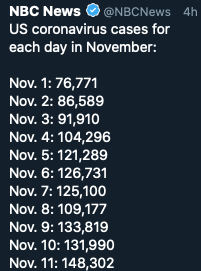
If you care at all, there is a program that can tell you what your risk level of contracting the virus is if you desire to go outside and attend various types of events. I don’t think people should be attending any voluntary event because, well, lots of people are dying. Plus, even if you don’t die, we don’t know the long-term effects of the virus.
https://covid19risk.biosci.gatech.edu/
There are other tabs to check other aspects. Bottom line; keep going out and around people without proper precautions, you will get it. We are going to have around a half million dead by inauguration.
We might well reach our death toll from World War II by the end of the year. Do you want to be part of that?
November 11, 2020
Day 246: 2020 Pandemic. The Inverse Rule of Security—the more you have, the less secure you are
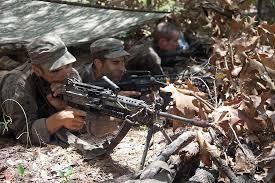
When I consult with clients about the Area Study and preparation for disastrous events, I often run into those who favor a fixed position for their Bug Out Hide Site. In fact, there are people who’ve poured millions of dollars into such a place.
There are many advantages to a fixed location.
There are also disadvantages.
One of those is the inverse rule of security. A fixed position is a known target. I often joke that the poor man’s survival guide is to find you nearest heavy prepper with a fixed site and take it. I get pushback from those people almost daring people to try it.
Then I have to walk them through how they are actually going to secure that site. One person cannot pull 24 hour security, seven days a week. You need more people. Every person you add, increases the security but also increases the threat.
Backing up from that, what about the people who built and stocked the fixed site? Unless one acts like an ancient Pharaoh and buries them inside (aka what I did in Area 51: Earth Abides) they know where it is. The locals know where it is. I have never deployed to any place in the world, even over a hundred miles from the nearest town, where the locals didn’t know we were there, no matter how covert we were trying to be. This applies to those who do it themselves on their own property. Your neighbors, no matter how distant, know you’re there and they have a good idea what you’re doing. I’m sure there are those who’ve gone so remote, they are hidden. Kudos to them. On the opposite end of that spectrum are the advertisements for multi-million dollar survival condos inside renovated missile silos. Nothing like advertising one’s location and I covered this scenario in Area 51: Invasion.
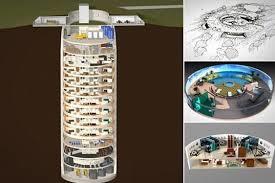
As a writer of both fiction and nonfiction, I have learned to improve each side by dipping my brain into the other. I had to think through a survival silo in writing those scenes in Invasion. At the same time, it caused me to update material in my Green Beret Preparation and Survival Guide.
So, you’re going to need guards. Here is an image of the security detail, publicly posted, for one of those silos. Note that there weapons take different calibers of ammunition, which by itself, rings a warning bell. I have no idea what the qualifications of these people are as far as security.

Also, the article which interviewed the owner, said the location was “Top Secret” but somewhere north of Wichita. First, the locals know where the missile silos were. Second, I was able to find the location with a two minute Google search. First result said two hours north in the Concordia area. A second search using that not only got me location but numerous pictures of the area. I’m not saying this is a totally bad idea. In fact, it has a lot going for it. Depending on the SHTF scenario. Which every survival scenario always comes down to– there are an infinite number of variables. That’s why I beat to death doing the personal Area Study to prepare for the most likely, from mild to most extreme. A survival silo condo is part of the possible solutions but should not be the only one.
I start with basic security of a patrol base, Ranger-handbook style. One key of that security is you know you can count on the other people in your unit to do their job and not turn on you. Not so in a SHTF scenario. In fact, if a situation becomes so extreme one must bug out to the fixed site, normal leverage, such as money, no longer is as important. Just because you built and funded the place doesn’t mean you maintain leadership when those two factors no longer count.
How will you maintain loyalty? Ultimately, the way is by building a ‘family’ that will bond together. Surprisingly, when I bring this up, the richer they are, the more negative the reaction.
Like many things in preparation and survival, it is an aspect few have thought through. Have you?
The Green Beret Preparation and Survival Guide. Also in Kindle Unlimited.



